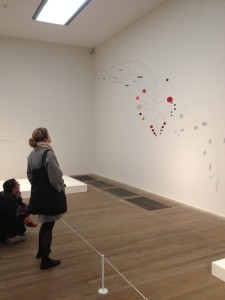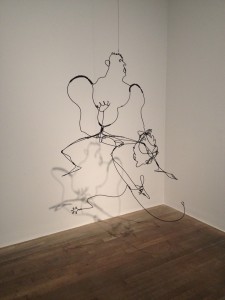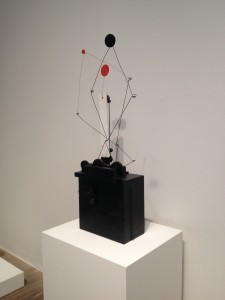Alexander Calder: Performing Sculpture – Tate Modern, London

While visiting this overall excellent and interesting exhibition at Tate Modern, I was thinking a lot about conservation versus comprehension. Warnings abound before and throughout the galleries not to move or blow on the works as they are now too fragile, but is a static mobile still a mobile? If an installation which relies on sound and movement has a guard to make sure nobody touches it and it doesn’t make a sound, is it still it’s authentic self, or just a memory? Does a lack of vibrancy and kinetic action fundamentally change a visitor’s understanding of Calder’s vision and methods? And what did the Tate do (or what could the Tate have done) in order to overcome this?
These thoughts were in my mind, but, as I mentioned at the outset, the exhibition was a very good one overall. The biographical introduction to Calder is fairly brief: artistic family, initially trained in mechanical engineering, but later studied art, and went off to Paris where he made some artist friends. It is hard to grasp in the context of our contemporary art scene how novel it must have been to see his early sculptures in wire: more void and transparency than those used to bronze, wood and stone would have seen before, humorous and already with a sense of lightness and movement lent them by their medium.

My slight disappointment with what I see as a missed opportunity, or flattening of the experience imagined by Calder, started fairly early on as well though, in room 2 where ‘Small Sphere and Heavy Sphere’ is displayed, and where the aforementioned guard makes sure that nobody gets to see it in action as originally intended. Part performance, part installation, part something else, the work is made up of a collection of objects, over which hang two spheres of different weights, which, when started in motion, bang against the objects in unexpected ways, producing different sounds and movements each time. A small display nearby shows ‘Small Sphere and Heavy Sphere’ in action, but it’s not really the same. The room seems a little bereft of energy, the work preserved in memory of its original purpose but lacking most of its point now.
I continued on my way through the exhibition however, and was variously charmed by the remnants of the Cirque Calder, Calder’s long terms project in which found objects were made into performers in shows staged for friends, and impressed by the developing abstraction and freedom of his works as they first mechanised and then began to hang from the ceiling, playing with what sculpture is, and with its potential to perform as well as to be viewed. This is, of course, the central idea of the exhibition, and is a fairly interesting one, although a little bit more context around what the contemporary reception of the works was and what his legacy has been, above and beyond the few snippets provided, would have helped me to better understand Calder’s place in art history. A bit of background on how his reputation has evolved over time, and what the curators were trying to achieve in placing him back within the context of modernist innovator, and this would have truly been a remarkable retrospective.

As it was, though, I was happy to see the many great examples of Calder’s mobiles in the latter half of the exhibition, taking inspiration from nature in some cases, and very much abstract in others. There were many other visitors congregated here, also pleased no doubt to see the works for which he is most famous, but also waiting like I was for a particularly brisk walker to set one or the other of them in slightly more vigorous motion. The dreamy almost stillness was entrancing, but after being shown so many formerly kinetic sculptures and told why they can’t now move, it would have been nice to see the mobiles coming out to play slightly more.
What can be done, though, when the works are indeed to fragile to set in motion? That depends, I think, on what your curatorial aims are. The curators of the Tate’s exhibition have done a fine job of showing the progression from first innovations to sleek and poised mobiles, emblems of American modernist optimism, as well as giving hints of his influence on performance art, composers of experimental music, and specific artistic movements in South America. What was missing for me as a visitor was an ‘authentic’ experience of Calder’s works as Calder intended them to be. Given that it’s not possible to set the kinetic ones going, have people play with the circus performers and assign visitor hosts to blow on the mobiles, could a little more have been done to provide less valuable stand-ins for the originals? A breakdown of the mechanics of the sculpture of a goldfish in its bowl? A side by side comparison of ‘Small Sphere and Heavy Sphere’ and a modern copy which can be set in motion? A look at the physics of the mobiles with workshops for those wanting to try it out themselves? Whether that is less or more authentic than seeing the originals stilled or behind glass is an interesting question, but it would provide a different entry point to understanding his work.

Thinking about it, maybe what I would actually like to see next, having seen some of the big hitters among Calder’s work at the Tate, is what a science museum or children’s museum might be able to do on the subject. For my 2017 wishlist: Alexander Calder: Investigating Sculpture. In the meantime Alexander Calder: Performing Sculpture is well worth seeing, as long as you can control your desire to set a mobile swinging.
